
. This philosophy was best exemplified by his design for Fallingwater
(1935), which has been called "the best all-time work of American architecture".
Pictures deface walls oftener than they decorate them.![]()
No house should ever be on a hill or on anything. It should be of the hill. Belonging to it. Hill and house should live together each the happier for the other.![]()
So here I stand before you preaching organic architecture: declaring organic architecture to be the modern ideal.![]()
A free America, democratic in the sense that our forefathers intended it to be, means just this: individual freedom for all, rich or poor, or else this system of government we call 'democracy' is only an expedient to enslave man to the machine and make him like it.![]()
Every great architect is — necessarily — a great poet. He must be a great original interpreter of his time, his day, his age.![]()
The physician can bury his mistakes, but the architect can only advise his clients to plant vines.![]()
I doubt if there is anything in the world uglier than a Midwestern city.![]()
Clear out 800,000 people and preserve it as a museum piece.![]()

